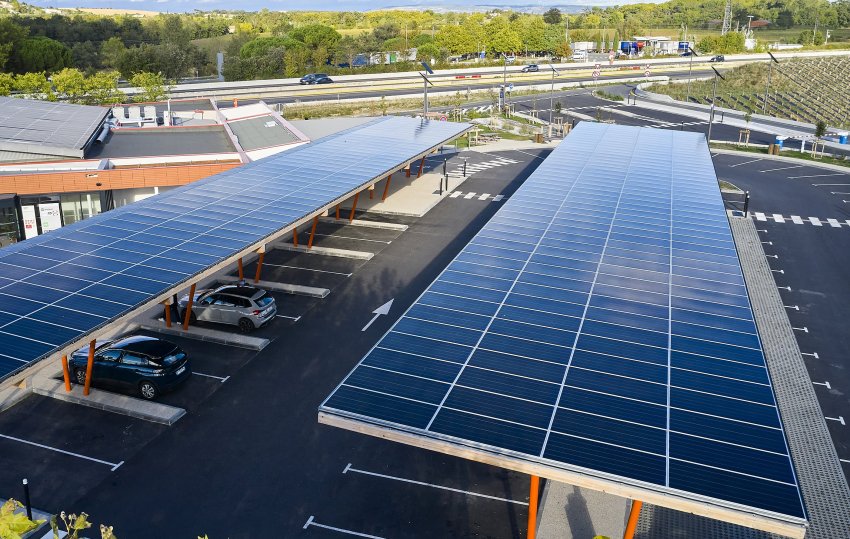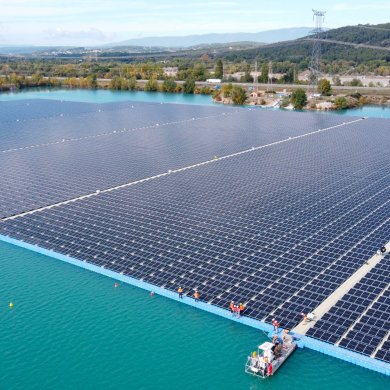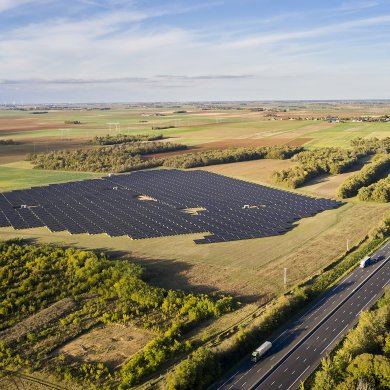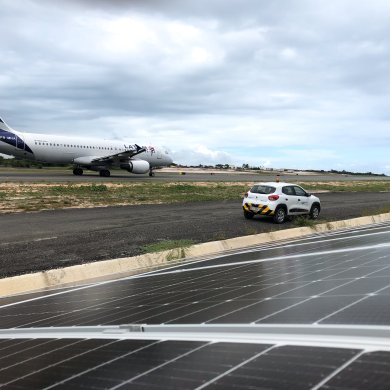
The top 7 unusual places for renewable energy plants
What are the options for building renewable infrastructure at a time when usable land is becoming scarce and the systems to harness energy from the sun and wind still take up considerable amounts of space? Here are a few attempts at solving the problem in places where you might not expect to see them.
Floating on lakes
More and more countries – especially the ones that have limited space, such as Japan – have started building floating solar farms. The principle is the same as on land and the only difference is that the panels are anchored to the bed or banks. The result is higher productivity and lower maintenance costs (the water helps to naturally cool the electric system). Installation costs, on the other hand, are still relatively high. These systems can be set up on irrigation reservoirs, storage pools and artificial lakes. In Germany, for example, the lake over a closed quarry in Hüdderath, North Rhine-Westphalia, will have a nine-hectare floating photovoltaic array, freeing up that much space for farmland.

In France at Peyrolles-en-Provence, 50 km from Marseille, a disused former gravel pit is now home to a solar power plant with 43,000 photovoltaic panels producing the equivalent of the annual electricity consumption of 25,000 inhabitants.
On rooftops
There are already plenty of photovoltaic panels on the roofs of homes and in car parks, for instance at the port of Antwerp. But not that many rooftop compact wind turbines. Wind My Roof, a startup working with Leonard (VINCI’s innovation and foresight platform) and with the teams at VINCI Energies, has developed a wind turbine that can be installed on any building with a flat roof and causes no noise pollution. The first of these is being trialled on the esplanade in the La Défense business district near Paris, to power a fleet of electric scooters.
Above and alongside motorways
Another idea, near Fully (Valais) in Switzerland this time, is to build a roof over a motorway. Here, a 1.6 km stretch of the A69 has been covered with 37,000 solar panels that supply enough electricity for 20,000 people a year. Another approach involves making the most of the hundreds of hectares of unused land alongside motorways. This is what Solarvia, a VINCI Autoroutes subsidiary that develops photovoltaic capacity, aims to do.

Solvarvia develops solar projects of all kinds (ground-mounted, floating, shading, etc.) throughout France. The VINCI Autoroutes subsidiary currently has 50 solar farms under development and 200 planned over the next five years.
Quarries, brownfields and other abandoned spots
Another issue is what to do with land that is no longer used and is unfit for farming, such as quarries or industrial wasteland. Or, more precisely, how to give it a second life. VINCI Energies has come up with one answer in Paulmy (Indre-et-Loire), in France, where it is building a solar plant on a former kaolinitic clay quarry for Neoen, a renewable energy specialist. Yves Daguin, the managing director at Omexom RE Solar, a VINCI Energies subsidiary, calls this project “a win-win-win, for the people here, the developers and the community as a whole.” Quarries have several advantages, including the fact that they are often holes in the ground and/or surrounded by forests, so the wind turbines or solar panels in them are out of sight. People living in the area and NGOs are therefore likelier to welcome them.
Out at sea
Offshore wind farms include turbines that are anchored to the seabed 10 km or more from the coast, and floating turbines sometimes much further away. They generate up to 60% more energy than conventional wind turbines* because the wind is stronger and steadier than on land. Offshore wind only accounted for 2.3% of Europe’s power production in 2019 but there are more and more of these projects in the pipeline – not least because Europe has the largest maritime area in the world. In the roadmap that the EU presented in 2020, the goal is to grow generation capacity from 12 GW today to 60 GW in 2030. The Dogger Bank wind farm off England’s North Sea coast, for instance, will power as many as 6 million homes.
At airports
Airports take up a lot of space. So why not make the most of the possibilities? VINCI Airports is developing renewable power production infrastructure throughout its network to do precisely that: to give buildings and open spaces a new purpose.

In Brazil at Salvador Bahia, a power plant comprising 11,000 solar panels has helped to reduce the airport's carbon footprint by 30%, and the same is true of Faro airport in Portugal. In France, at Lyon-Saint Exupéry, the largest shaded solar power plant for car parks in France, covering 5,800 parking spaces over 14 hectares and producing 24 GWh of green electricity a year, equivalent to the consumption of 9,000 inhabitants, will soon see the light of day.
In building façades
Did you ever think walls could produce electricity? Well, they can: ActivSkeen, a VINCI Construction subsidiary, has integrated photovoltaic technologies into building cladding to produce green energy. This technique has been used to limit the environmental impact of l’archipel, VINCI’s headquarters among other buildings.
Most viewed
Explore more
Words from researchers: let's fight stereotypes!
Charlotte, a research fellow at École des Mines, and Erwan, a university professor and researcher at AgroParisTech, talk…
Fondation VINCI pour la Cité: opening the door to others is another way of reaching out!
With some 1.3 million organisations and 2 million employees, France can lay claim to a dynamic network of associations…
Sea water desalination: a solution for turning the tide on the water scarcity crisis?
As water shortages continue causing havoc in a growing number of regions around the world, an age-old idea is experiencing a…


